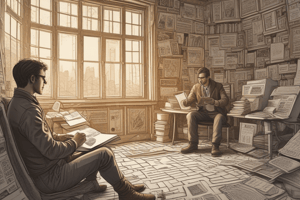Podcast
Questions and Answers
Which of the following best describes the primary goal of a feature article?
Which of the following best describes the primary goal of a feature article?
- To explore issues, opinions, and experiences in detail. (correct)
- To present breaking news in a concise format.
- To provide a summary of recent events.
- To strictly report facts without personal perspectives.
What is the purpose of brainstorming ideas in the feature article writing process?
What is the purpose of brainstorming ideas in the feature article writing process?
- Generate a wide range of potential topics and angles. (correct)
- Determine the article's final conclusion.
- Select the sources for research.
- Create the article's headline.
Which element is most crucial for grabbing a reader's attention in a feature article?
Which element is most crucial for grabbing a reader's attention in a feature article?
- A lengthy introduction with detailed background information
- A provocative or unusual opening statement (correct)
- An extensive list of statistics.
- A comprehensive literature review.
Why is the use of subheadings important in the details/main article section of a feature?
Why is the use of subheadings important in the details/main article section of a feature?
What role do anecdotes play in feature article writing?
What role do anecdotes play in feature article writing?
What is the purpose of using rhetorical questions in feature articles?
What is the purpose of using rhetorical questions in feature articles?
In the context of a feature article, what does a 'tear-out section' typically consist of?
In the context of a feature article, what does a 'tear-out section' typically consist of?
When crafting a captivating science feature article, why is it important to 'highlight the wow factor'?
When crafting a captivating science feature article, why is it important to 'highlight the wow factor'?
In editorial writing, what is the primary purpose of using ethos as an element of persuasion?
In editorial writing, what is the primary purpose of using ethos as an element of persuasion?
Why is it important to maintain a consistent tone throughout an editorial?
Why is it important to maintain a consistent tone throughout an editorial?
What role does 'exaggeration' play in effective cartooning?
What role does 'exaggeration' play in effective cartooning?
Why is it important for cartoons to avoid stereotypes?
Why is it important for cartoons to avoid stereotypes?
In the context of a campus paper, what is the 'lead'?
In the context of a campus paper, what is the 'lead'?
What does 'balance' refer to in the qualities of a good layout?
What does 'balance' refer to in the qualities of a good layout?
Which of the following best describes the 'modular' type of layout?
Which of the following best describes the 'modular' type of layout?
What is the purpose of the 'dummy' layout in newspaper design?
What is the purpose of the 'dummy' layout in newspaper design?
What is the main consideration for layout design in Philippine campus papers?
What is the main consideration for layout design in Philippine campus papers?
How does the choice of fonts in newspaper design impact the publication?
How does the choice of fonts in newspaper design impact the publication?
Why is it important to be cautious when using color in layout design?
Why is it important to be cautious when using color in layout design?
According to the conclusion, what role do future journalists, cartoonists, and designers play in their community?
According to the conclusion, what role do future journalists, cartoonists, and designers play in their community?
Flashcards
What is a Feature Article?
What is a Feature Article?
Informs, entertains, and persuades; explores a range of issues, opinions, experiences, and ideas in detail.
What are the 4 parts of a feature article?
What are the 4 parts of a feature article?
Title & Headline, Introduction, Details/ Main Article, Conclusion.
What is the purpose of a Title & Headline?
What is the purpose of a Title & Headline?
Grabs attention and persuades to read; highlights the main idea.
What does an introduction do?
What does an introduction do?
Signup and view all the flashcards
What is the purpose of the conclusion?
What is the purpose of the conclusion?
Signup and view all the flashcards
Why use slang in feature articles?
Why use slang in feature articles?
Signup and view all the flashcards
What is a 'Feature'?
What is a 'Feature'?
Signup and view all the flashcards
Use of metaphors and analogies.
Use of metaphors and analogies.
Signup and view all the flashcards
Highlight the 'wow' factor.
Highlight the 'wow' factor.
Signup and view all the flashcards
What is an Editorial?
What is an Editorial?
Signup and view all the flashcards
Importance of Editorials.
Importance of Editorials.
Signup and view all the flashcards
3 Editorial Types (PEC)
3 Editorial Types (PEC)
Signup and view all the flashcards
What are Persuasive editorials?
What are Persuasive editorials?
Signup and view all the flashcards
What is Explanatory editorial?
What is Explanatory editorial?
Signup and view all the flashcards
Commendatory Editorial?
Commendatory Editorial?
Signup and view all the flashcards
Selecting a relevant issue.
Selecting a relevant issue.
Signup and view all the flashcards
Editorial Structure.
Editorial Structure.
Signup and view all the flashcards
Ethos
Ethos
Signup and view all the flashcards
Pathos relates to?
Pathos relates to?
Signup and view all the flashcards
Logos means:
Logos means:
Signup and view all the flashcards
Study Notes
Feature Article Overview
- Feature articles inform, entertain, and persuade
- Feature articles explore issues, opinions, experiences, and ideas in detail
Steps to Writing Feature Articles (BWR-GKL)
- Brainstorm ideas to start the writing process
- Define the purpose to give direction to the article
- Research the topic to provide credible information
- Grab the reader’s attention early in the article
- Keep the reader's attention throughout
- Leave a lasting impression with the conclusion
Structure of a Feature (TIDC)
- Start with a title and headline to engage readers
- Provide an introduction to draw readers in
- Include details or the main article for the body
- End with a conclusion to summarize the piece
Title & Headline Details
- Designed to grab attention and persuade reading
- Highlights the article's central theme
Introduction Details
- Provokes interest with unique statements or hooks
- Provides necessary background information
- May invite debate by presenting controversial viewpoints
Details/Main Article
- Use subheadings to organize for readability
- Incorporate facts and statistics to support claims
- Present personal viewpoints to connect with the reader
- Include expert opinions to build trust
- Use quotes and interviews to add credibility
- Incorporate anecdotes and stories for engagement
Conclusion Details
- Reminds the reader of the article's main idea
- Suggests a course of action to give the reader guidance
- Encourages changing attitudes or opinions
Language in Feature Articles
- Use a personal tone with informal language and first-person narrative
- Include relevant jargon to add authenticity
- Use anecdotes to keep the reader engaged
- Include facts to validate the viewpoints
- Pose rhetorical questions to engage the reader
- Use emotive words to create a personal response
- Employ imagery and description to engage the reader's imagination
- Use direct quotes to add a personal touch to the topic
News vs. Feature Article Styles
- News articles use a bold, clever headline
- News introduce the main idea upfront
- News include paragraphs elaborating on the lead with examples
- News utilize tear-out sections to highlight information in a larger font
- Feature articles use a column format
- Feature articles mix facts with emotional content
- Feature articles use emotive and descriptive language, jargon, or technical terms
- Feature articles may include authoritative quotes from important people
- Feature articles include graphics to enhance the content
Steps for Science Feature Articles (CDC-BW)
- Choose a topic that blends scientific complexity with human interest
- Identify an engaging "hook"
- Research by consulting reputable sources is necessary
- Balance in-depth information with accessibility in language and tone
- Fact-check meticulously to maintain credibility
- Craft a compelling headline and introduction to entice readers
- Use a catchy headline to grab attention
- Start with a strong opening paragraph to highlight the "hook"
- Build the body of the article with a logical structure
- Use storytelling techniques to engage readers
- Emphasize human involvement to create relatability
- Write a satisfying conclusion that summarizes key points to leave a lasting impression
- Offer insights into future implications or open questions for further exploration
- End with a thought-provoking statement or call to action
Techniques & Tips for Science Feature Articles (UHAMP)
- Use metaphors and analogies to translate complex ideas
- Highlight the "wow" factor to emphasize aspects of science
- If relevant, address potential controversies to ensure balance
- Maintain objectivity by avoiding personal opinions unless relevant
- Proofread and edit rigorously to ensure accuracy and clarity
Editorial Defined
- Expresses the author's opinion
- A column represents one person's voice, not the newspaper's
- A column can take a stance on any topic
Importance of Editorials (IPA)
- Editorials influence public opinion
- Editorials promote critical thinking
- Editorials advocate for change
Types of Editorials (PEC)
- Persuasive editorials convince readers to think or act in a certain way
- Explanatory editorials explain complex issues
- Commendatory editorials praise or celebrate individuals or initiatives
Choosing an Editorial Topic
- Select current events and hot topics
- Address matters of public concern
- Ensure significance to the readership
Researching an Editorial Topic
- Use credible sources for gathering information
- Verify facts and statistics to ensure integrity of the work
- Understand different perspectives by considering opposing viewpoints
- Acknowledge counterarguments to address biases effectively
Formulating an Editorial Opinion
- Develop a clear stance by being specific about your position
- Ensure your position is defensible and rational with logical evidence
- Draw from personal experience where relevant
Structuring Editorials
- Introduce the issue and your opinion
- Provide evidence and arguments in the body
- Reinforce your stance and suggest action in the conclusion
Strong Opening
- Capture attention immediately
- Set the tone for the rest
Persuasive Argument Elements
- Ethos: Establish credibility
- Pathos: Appeal to emotions
- Logos: Use logic and facts
Writing Style
- Use clear, concise language to promote understanding
- Maintain a consistent and appropriate tone based on the subject matter
- Stylistic devices like metaphors, analogies, and anecdotes enhance writing
- Avoid clichés and jargon for clarity
Headlines and Subheadings
- Headlines must be impactful, provocative, accurate and use action words
- Subheadings break up text and guide the reader
Legal and Ethical Considerations
- Avoid libel and defamation with fact-checked writing
- Disclose conflicts of interest to maintain integrity
Developing an Editorial Voice
- Have a distinctive voice that reflects your brand
- Maintain a consistent tone throughout
- Experiment with different writing styles to convey the message effectively
Editorial Writing Guide
- Choose a topic, develop a thesis, and research
Structure
- Introduction, body, and conclusion
Editorial Cartoons
- Graphic commentary on current events or social issues
- Uses imagery and text to convey a pointed message
- Found in campus publications
Qualities of Effective Cartoons (SESIH)
- Simplicity: Instant message
- Exaggeration: Emphasize features
- Symbolism: Uses recognizable representations
- Irony: Highlights absurdities
- Humor: Engages audience
Cartooning Techniques
- Caricature: Exaggerates features for likeness
- Analogy: Compares unlike things
- Labeling: Identifies cartoon elements
- Symbolism: Incorporates symbolic representations
Cartooning Tools
- Traditional: Pencils, inks, brushes, and paper
- Digital: Tablets, pens, and graphic software
Satire
- Satire uses humor, irony, and exaggeration
- Common in editorial cartoons
- Use carefully to avoid misinterpretation
Ethical Cartooning
- Respect dignity of individuals and groups
- Avoid stereotypes
- Consider the impact on audience
Campus Paper Parts
- Headline: Grabs attention
- Byline: Writer's name
- Lead: Opening paragraph summary
- Body: Main text
Layout Qualities
- Clarity: Easy to read
- Balance: Even visual distribution
- Contrast: Elements stand out
- Unity: Cohesive layout
Layout Types
- Modular: Organized blocks
- Circus: Mix of stories
- Picture-window: Dominated by large image
The Dummy
- Preliminary layout
- Plans placement; visualizes
- Sketches on paper or uses software
Desktop Publishing Overview
- Software designs documents
- Precise layout control
- Common programs: Adobe InDesign, Microsoft Publisher
Philippine Layout
- Influenced by aesthetics and standards
- Balances text, images, and white space
- Often bilingual
Integrating Photos
- Adds visual interest
- Placement affects balance
- Captions provide context
Typography
- Fonts set tone
- Headlines and body require treatments
- Consistency maintains look
Color Theory
- Evokes emotions
- School colors reinforce identity
- Balance overuse
Conclusion
- You shape the campus news
- Creativity and ethics influence discourse
- Impact the community
Studying That Suits You
Use AI to generate personalized quizzes and flashcards to suit your learning preferences.



